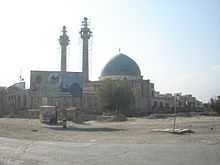Shia Islam in Afghanistan

Shia Islam in Afghanistan is practiced by 19 to 25% of the population.[2][3][4][5] Afghan Shia are primarily the Twelvers, while a minority are Ismailis.
Twelvers
The majority of Afghan Shia are Twelvers, primarily of the Hazara ethnicity. The next-largest Twelver community are the Farsiwan of the western Herat and Farah provinces. Other, far smaller, Afghan Twelver communities include the Bayat and Qizilbash populations, as well as some of those who claim to be Sayeds.
Ismailis
A smaller portion of Afghan Shia are Nizari Ismailis ("Seveners"); these populations include many of the Pamir language speakers of the northeastern portion of the country (predominantly in Badakhshan Province bordering Tajikistan).
Baghlan Province is also home to an Ismaili community, the Sayeds of Kayan. Their leader is Sayed Mansur Naderi and his son, Sayed Jaffar Naderi.[6] During the Soviet-Afghan War, about 10,000 Ismaili militamen defended the Baghlan Ismaili stronghold of Kayan. They have sided with the Soviets due to differences with the other groups of fighters.[7] Unlike other Ismaili communities in the region and worldwide, the Baghlan Ismailis do not defer to the spiritual leader of Ismailis worldwide, the Agha Khan.[6]
See also
References
- ↑
- ↑ "Mapping the Global Muslim Population: A Report on the Size and Distribution of the World’s Muslim Population". Pew Research Center. October 7, 2009. Retrieved 2010-09-03.
Afghanistan 8-12% Shi'a
- ↑ Miller, Tracy, ed. (October 2009). Mapping the Global Muslim Population: A Report on the Size and Distribution of the World's Muslim Population (PDF). Pew Research Center. Retrieved 2010-09-03.
- ↑ "Country Profile: Afghanistan". Library of Congress Country Studies. August 2008. Retrieved 2010-09-03.
Religion: Virtually the entire population is Muslim. Between 92 and 87 percent of Muslims are Sunni and 8 to 12 percent, Shia.
- ↑ "Afghanistan". Central Intelligence Agency. The World Factbook. Retrieved 2010-09-03.
- ↑ 6.0 6.1 Hindokosh, May 2003 at UNHCR.org
- ↑ Michael V. Bhatia; Mark Sedra (2008). Afghanistan, arms and conflict: armed groups, disarmament and security in a post-war society. Psychology Press. pp. 252–. ISBN 978-0-415-45308-0. Retrieved 30 March 2011.
External links
| ||||||||||||||